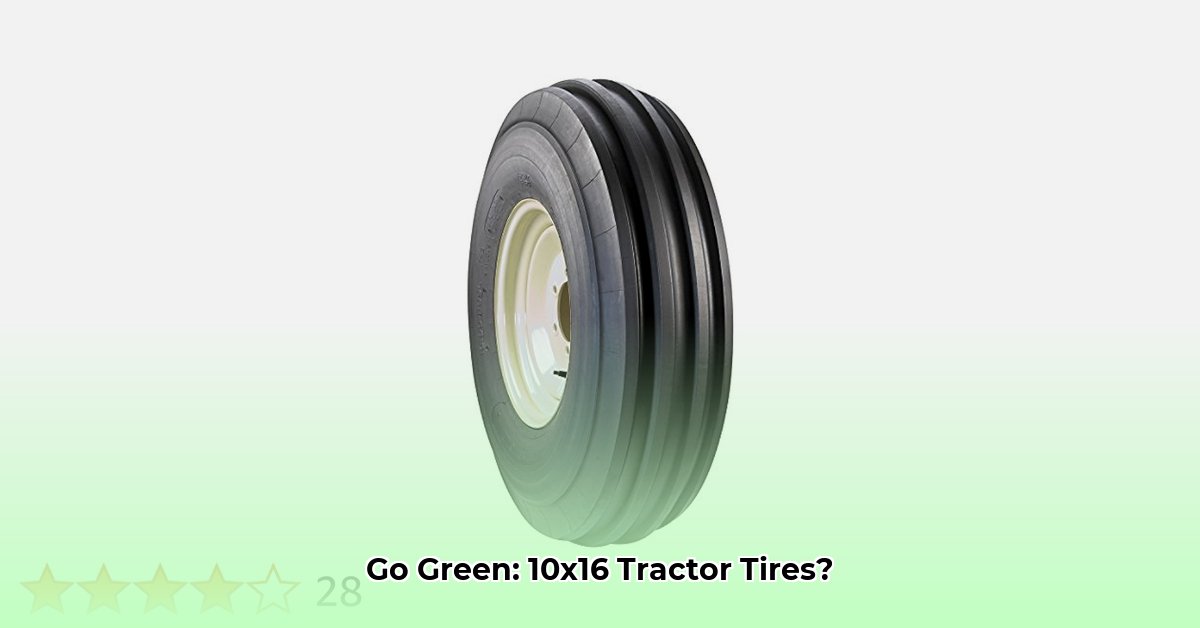
Choosing the Right 10x16 Tractor Tires for Your Farm
Selecting the appropriate 10x16 tractor tires significantly impacts your farm's efficiency and operational costs. This guide compares popular options, focusing on practical advice for sustainable farming practices. We'll explore factors to consider when choosing tires, highlighting the importance of soil type and workload in the decision-making process. Maintaining your tires properly is also crucial for maximizing their lifespan and minimizing environmental impact. For more tire size information, check out this helpful tire size chart.
Understanding Your Farming Needs: Soil and Workload
Before selecting tires, assess your farm's specific needs. What type of soil do you cultivate? Heavy clay soil requires different tire characteristics than lighter, sandier soil. What are your primary farming tasks? Heavy hauling demands different tire specifications than lighter tillage operations. These factors influence tire selection – do you prioritize fuel efficiency, maximum traction in muddy conditions, or a balance of both? A well-informed choice equates to smoother operation and avoids costly downtime related to tire failures.
The Carlisle Trac Chief: A Dependable Workhorse
The Carlisle Trac Chief is a popular choice for its robust construction and performance. Its flatter profile enhances stability, reducing the risk of tipping or wobbling, especially when carrying heavy loads. The deep, aggressive tread pattern provides excellent traction in challenging conditions such as mud and wet fields. The reinforced sidewalls contribute to durability and puncture resistance, extending the tire's lifespan. This combination of features makes it a versatile choice for various farming tasks.
Agri-Supply 10x16 PRTT Tires: A Need for More Information
Detailed specifications for Agri-Supply 10x16 PRTT tires are currently limited, hindering a direct comparison with the Carlisle Trac Chief. To perform a comprehensive analysis, we need further information on load capacity, tread depth and pattern, and the tire's construction materials. This information is vital for evaluating the tire's performance and its contribution to sustainable farming practices. More research is needed to understand its full capabilities.
Comparing Tire Options: A Preliminary Look
Due to insufficient data on Agri-Supply tires, a thorough comparison is currently impossible. However, this table summarizes the available information:
| Feature | Carlisle Trac Chief | Agri-Supply 10x16 PRTT |
|---|---|---|
| Availability | Widely available from various retailers | Available exclusively through Agri-Supply |
| Load Capacity | High (Specific data required for precise comparison) | To be determined |
| Tread Pattern | Deep, aggressive lugs for excellent traction | Unknown |
| Sidewall | Reinforced for durability and puncture resistance | Unknown |
| Sustainability | Contributes through durability and potential fuel efficiency (dependent on rolling resistance) | Requires further investigation |
Sustainable Farming and Tire Selection: Minimizing Environmental Impact
Sustainable farming practices prioritize efficiency and minimal environmental impact. Tire selection plays a crucial role. Tires with lower rolling resistance reduce fuel consumption. Wider tires minimize soil compaction, maintaining soil health and productivity. Longer-lasting tires reduce waste, lessening the environmental burden. These interrelated factors highlight the importance of choosing tires carefully, factoring in both immediate and long-term effects.
Steps to Choosing the Right Tires for Your Farm
- Assess Your Needs: Evaluate soil type, workload, and priorities (fuel efficiency, traction, etc.).
- Gather Specifications: Obtain detailed information on load capacity, construction materials, and tread patterns for each tire under consideration.
- Compare and Contrast: Analyze competing brands and models, weighing pros and cons based on your specific needs.
- Seek Expert Advice: Consult with agricultural professionals, equipment dealers, or experienced farmers for insights.
- Consider Long-Term Costs: Analyze the long-term cost-effectiveness (return on investment, ROI) of each tire option. A higher initial cost might be offset by extended lifespan and reduced maintenance.
Maintaining Your 10x16 Tractor Tires: Extending Lifespan
Regular maintenance is essential for maximizing tire lifespan and performance. Regularly check tire pressure to avoid both underinflation (which accelerates wear and reduces fuel efficiency) and overinflation (that could damage the tire). Avoid overloading the tractor – exceeding the tire's load capacity greatly reduces its useful life. Implementing a tire rotation schedule ensures even wear across all tires. These practices extend tire lifespan, reduce costs, and minimize waste.
Making Your Final Decision: Prioritize Your Needs
Choosing the right 10x16 tractor tires requires careful consideration of various factors. While the Carlisle Trac Chief offers a strong, readily available option with proven reliability, a comprehensive comparison requires more information on alternative options like the Agri-Supply PRTT tires. Prioritize your individual farming needs and sustainability objectives when making your final decision.
How to Choose Sustainable Agricultural Tires for Reduced Soil Compaction
Key Takeaways:
- Lower tire pressure reduces soil compaction.
- Larger contact patches minimize ground pressure.
- Michelin UltraFlex technology offers a promising solution for reduced soil compaction.
- Long-term benefits outweigh initial investment costs.
- Thorough evaluation of soil type and operational needs is crucial.
Soil compaction significantly reduces water infiltration, root growth, and crop productivity. Tires with larger footprints and operating at lower pressures effectively mitigate compaction. Michelin UltraFlex technology allows for significantly lower inflation pressures without compromising structural integrity, resulting in reduced compaction and improved soil health.